Note
Seeing your master chart of languages, I must ask if you used any plugins. If so, which ones? Or, if not, how do you get those effects such as the text outside of the boxes and within the connecting lines?
it's all vanilla! obsidian continues to be kinda cracked.
the most lifesaving plugin i do use is 'interlinear glossing:'


must-have for anyone conlanging with obsidian, imo. my favourite glossing tool.
7 notes
·
View notes
Note
So, How many conlangs have you made and which one would you consider the weirdest?
in terms of actually finished conlangs: three. Olmic, which was bad, Orsyepok, which is still bad but less so, and most recently High Gavellian, which is also bad (affectionate).
i have seventy thousand languages in progress.
no not really. but all my languages are part of the utterly gargantuan set of families i have set on an entire continent that i decided to make every single major language for over the course of like 2500 years. 'biting off more than you can chew' is an understatement, i'll be chipping away at this until i die.

in terms of languages i've put notable work into:
proto-auray-gavellian is the highest grey box on the chart. it's fairly robust at this point, only because it sorta has to be. it's mainly a vocab generator at this point. i've also rather fleshed out its immediate descendants: proto-aurayin, ancient gavellian, and liesyu. the former two are robust enough that i regularly do translations with them.
ancient gavellian is the most robust of the three. i could probably document it, and its wordlist is gigantic. its most fleshed out descendant is the archaic high gavellian, but there's a billion low gavellians (the 'veniésate') hanging around in a massive romance-style dialect continuum.
old lakeshore gavellian, kaande, and sogoic, are the three most fleshed-out ones, with their own sound systems, grammatical rules, and vocab lists (though much of it is base imported from ancient gavellian). koine gavellian, proto-llevic, and demotic gavellian are less-fleshed out. the former is a shadow vernacular sitting right underneath high, while the latter two are future-sogoic and future-koine respectively.
finally, there's the eastern sprachbund i've started working on. a lot of the time, i call it the east "gavellian" sprachbund, but i should really stop doing that. i do it because the continent was named by and after the gavellian-speakers; none of the eastern sprachbund languages are in the gavellian family.
i'm feeding into that sprachbund three languages: a yet-unnamed dwarvish language in its own family as a central lingua franca pillar, as well as a dialect of aurayin & a language isolate i'm calling vindalic for historic wynnlangs reasons. it's still very young, i haven't started properly sprachbunding it yet.
with the exception of Orsyepok, i've really been neglecting the aurayin branches, which are pretty much the entire left quarter of the chart. this is because they're all very ergative and ergativity is scary (real).
as for weirdest...
idk. at this point i've been barraged with enough natlangs to accept that any "weird" feature i try and come up with already exists in a language with 10m+ speakers.
the (older) Gavellian clausal system (merger of complementizers, prepositions, pronouns articles, and tense verbs into a macroclass) is the closest i feel like i've gotten to a "genuinely weird' feature. but again, idk.
what have you been working on?
4 notes
·
View notes
Note
So, How many conlangs have you made and which one would you consider the weirdest?
in terms of actually finished conlangs: three. Olmic, which was bad, Orsyepok, which is still bad but less so, and most recently High Gavellian, which is also bad (affectionate).
i have seventy thousand languages in progress.
no not really. but all my languages are part of the utterly gargantuan set of families i have set on an entire continent that i decided to make every single major language for over the course of like 2500 years. 'biting off more than you can chew' is an understatement, i'll be chipping away at this until i die.

in terms of languages i've put notable work into:
proto-auray-gavellian is the highest grey box on the chart. it's fairly robust at this point, only because it sorta has to be. it's mainly a vocab generator at this point. i've also rather fleshed out its immediate descendants: proto-aurayin, ancient gavellian, and liesyu. the former two are robust enough that i regularly do translations with them.
ancient gavellian is the most robust of the three. i could probably document it, and its wordlist is gigantic. its most fleshed out descendant is the archaic high gavellian, but there's a billion low gavellians (the 'veniésate') hanging around in a massive romance-style dialect continuum.
old lakeshore gavellian, kaande, and sogoic, are the three most fleshed-out ones, with their own sound systems, grammatical rules, and vocab lists (though much of it is base imported from ancient gavellian). koine gavellian, proto-llevic, and demotic gavellian are less-fleshed out. the former is a shadow vernacular sitting right underneath high, while the latter two are future-sogoic and future-koine respectively.
finally, there's the eastern sprachbund i've started working on. a lot of the time, i call it the east "gavellian" sprachbund, but i should really stop doing that. i do it because the continent was named by and after the gavellian-speakers; none of the eastern sprachbund languages are in the gavellian family.
i'm feeding into that sprachbund three languages: a yet-unnamed dwarvish language in its own family as a central lingua franca pillar, as well as a dialect of aurayin & a language isolate i'm calling vindalic for historic wynnlangs reasons. it's still very young, i haven't started properly sprachbunding it yet.
with the exception of Orsyepok, i've really been neglecting the aurayin branches, which are pretty much the entire left quarter of the chart. this is because they're all very ergative and ergativity is scary (real).
as for weirdest...
idk. at this point i've been barraged with enough natlangs to accept that any "weird" feature i try and come up with already exists in a language with 10m+ speakers.
the (older) Gavellian clausal system (merger of complementizers, prepositions, pronouns articles, and tense verbs into a macroclass) is the closest i feel like i've gotten to a "genuinely weird' feature. but again, idk.
what have you been working on?
4 notes
·
View notes
Text
Took forever. But now I can finally start working on the thing. For real.
Here's all three of the main languages about to create the east gavellian sprachbund:

2 notes
·
View notes
Text
Here's all three of the main languages about to create the east gavellian sprachbund:

#east gavellian sprachbund#yet unnamed dwarf lang#east aurayin#vindalic#“sprachbund” is a bit misleading. these languages are NOT about to be familial with one another#polycule hours#the gloss has my rapidly-mutating etymology/ablaut proto romanization. it's Not sane#a better rendering is smth more like#Yin ghani ho ya'anhu qenja enfeku 'enli
2 notes
·
View notes
Text
hello i managed to emerge from my conlanging block and worked on sentian a little bit so have this phrase that can be very useful to know the meaning of if you happen to know a guy named kirjan of ken sent

Ni sâýlar nas-rasyhanz.
1S kill-PST 1S.POSS.REFL-father-ACC
"I killed my father."
sentian has two ways for marking possession – pronouns and prefixes. the pronouns are generally considered more polite and respectful (and archaic in some contexts) and are required to be used with certain words (mainly kinship terms and titles) while the prefixes are more casual. for some speakers, they are divided by animacy with the pronouns used for animate nouns and the prefixes for inanimate nouns
now if you really hate your father there is nothing better than to use the prefixes, especially when he is a noble and de facto king of sentia. you are referring to him as if he was just some pebble you stepped on earlier. he sure would be mad if he were alive
17 notes
·
View notes
Text
New Proto New Sound System
language's current endonym is feth.le, but i call it "vindalic" or "the proto-ahms-substrate" in my notes. i'll make the former an exonym if the future sound system doesn't let me.
so here's the entire proto's sound system document.
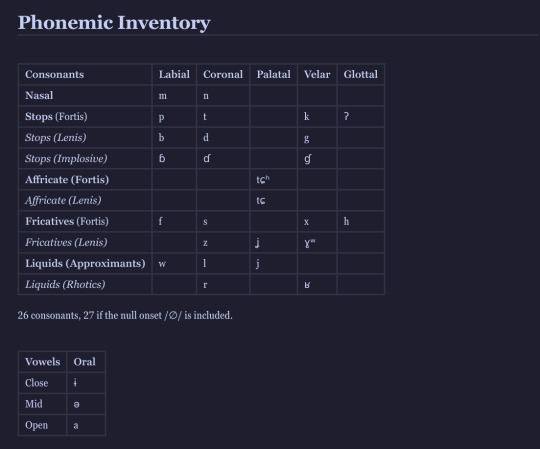






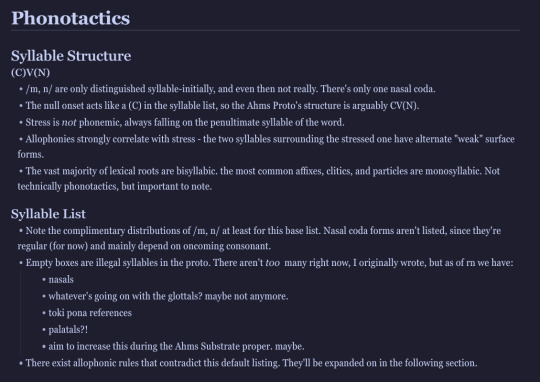
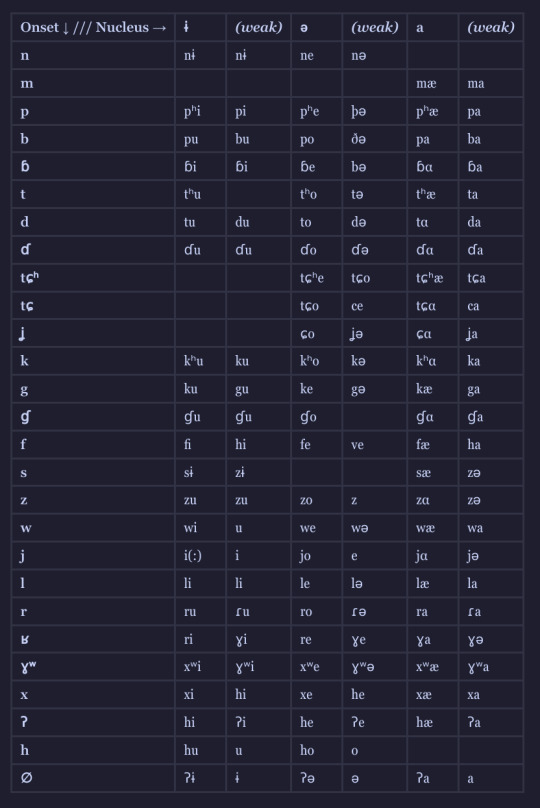
2 notes
·
View notes
Text
youtube
William is back! And he's giving us an overview of subordinate clauses. So tune in to learn all the ways your conlang can stick a sentence... in a sentence!
6 notes
·
View notes
Text

When the weird uncle brings up *dw > erk during Christmas dinner again
77 notes
·
View notes
Text
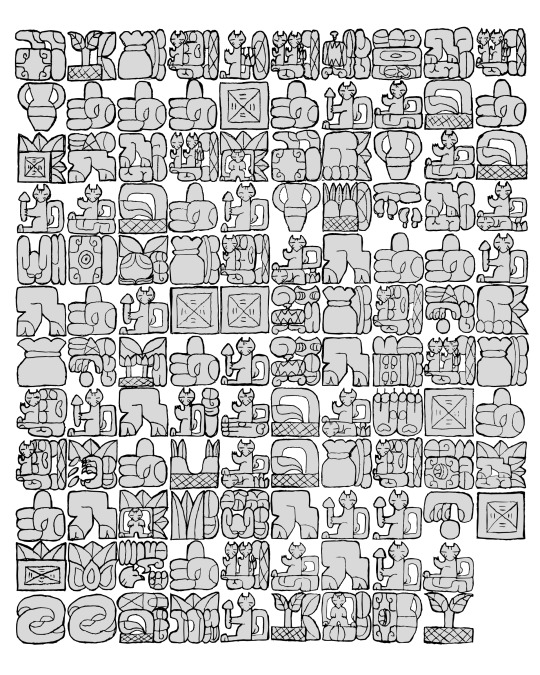
Heya! I wanted to show off a bit of the new language, Ancestral (Mīriñëu)! Above is the writing of the translation of the Lord's Prayer, and below is the translation. Very happy I finally get to show this!
Rrōlonwē ñāw tlāw ñā përar,
/ˈrɔ́.lɔˌnʷɛ́ ˈɲáw t͡ɬáw ˈɲá ˈpǽ.ɾaɾ/
heaven-ADE be-PV.IPFV.PCP all-GEN 1SG.GEN father-DAT
"Our Father in heaven"
Mėñā ñëuñėro ëña wimīubėu.
/mæˈɲá ˈɲǽù̯.ɲæ.ɾo ˈǽ.ɲa wɪˈmɪ́ù̯.bæu̯/
2SG.GEN name-ERG[TOP] honor-IPFV.PV.INF NPST.3-SBJV-PFV.PV
"May your name be honored."
Mėñā īmimāed tāoc wimīubėu.
/mæˈɲá ˈɪ́.mɪˌmáɛ̯̀d ˈtáò̯c wɪˈmɪ́ù̯.bæu̯/
2SG.GEN kingdom-ERG[TOP] come-IPFV.PV.INF NPST.3-SBJV-PFV.PV
"May your kingdom come."
Mėñā īed rrōlonwē lāe ëdrra cōl wimīubėu.
/mæˈɲá ˈɪ́ɛ̯̀d ˈrɔ́.lɔˌnʷɛ́ ˈláɛ̯̀ ˈǽ.dra ˈcɔ́l wɪˈmɪ́ù̯.bæu̯/
2SG.GEN will-ERG[TOP] heaven-ADE as earth-ADE do-IPFV.PV.INF NPST.3-SBJV-PFV.PV
"May your will be done on earth as it is in heaven."
Mėulo rrīmwe nōad tlārr ñārr;
/ˈmǽù̯.lɔ ˈrɪ́.mʷɛ ˈnɔ́à̯d ˈt͡ɬár ˈɲár/
NPST.2-give-IPFV.AV day-GEN food-ERG all-DAT we-DAT
"Give us today our daily bread"
Mėjyëlėlo tlāw ñā tëulėro, lāe tlė ñë tëulėro ñōlaw tlwēs cyëlanabāol.
/mæˈgʲǽ.læ.lɔ ˈt͡ɬáw ˈɲá ˈtǽù̯.læ.ɾɔ ˈláɛ̯̀ t͡ɬæ ˈɲǽ ˈtǽù̯.læ.ɾɔ ˈɲɔ́.law ˈt͡ɬʷɛ́s ˈkʲǽ.la.naˌbáò̯l/
NPST.2-forgive-IPFV.AV all-GEN we-GEN mistake-ERG as all-ABS we-ABS mistake-ERG happen-IPFV.AV.PCP person-ERG NPST.1-forgive-PFV.AV
"And forgive us our debts, as we ourselves have forgiven our debtors."
Mėwëulalři mėñārr tlāw ñā īdlio īen, ēo mėxřēlabāol tlāz ñās mëulamarėu.
/mæˈwǽù̯.lal.ɻʷɪ mæˈɲár ˈt͡ɬáw ˈɲá ˈɪ́.d͡ɮɪo̯ ˈɪ́ɛ̯̀n ˈɛ́ò̯ mæˈʝɻʷɛ́.laˌbáò̯l ˈt͡ɬáz ˈɲás ˈmǽù̯.la.ma.ɾæu̯/
NPST.2-lead-IPFV.AV=NEG you-DAT all-GEN we-GEN harm-IPFV.AV.PCP intent-PER but NPST.2-bring-PFV.AV all-ERG we-ERG darkness-ABL
"And do not lead us into temptation, but deliver us from evil."
Tlibīerr īmimëi ė ñōloė ė cwëña pëuaw īriloo mėñās woñāl.
/t͡ɬɪˈbɪ́ɛ̯r ˈɪ́.mɪˌmǽì̯ æ ˈɲɔ́.lɔæ̯ æ ˈcʷǽ.ɲa ˈpǽù̯.aw ˈɪ́.ɾɪ.lɔː mæˈɲás wɔˈɲál/
because kingdom-ABS[TOP] and power-ABS[TOP] and glory-ABS[TOP] end-GEN_without 2SG.ERG NPST.3-be-IPFV.AV
"For yours is the kingdom, the power, and the glory, forever."
Āz tlīwiñāl.
/ˈáz ˌt͡ɬɪ́.wɪˈɲál/
this-ERG[TOP] CRAS.3-be-IPFV.PV
"Amen."
18 notes
·
View notes
Text
Finished an example paradigm for a Ni- final noun and I'm very happy with this rehaul of the nominal declention system. like look at this before and after!!-
before: sad, too grid-like, a single lonely case of syncretism (sg. erg. and acc.)


As opposed to after: sexy, beautiful, two more columns added, no shortage of syncretized cells - some across the entire system, some only in certain patterns, full! tripartite marking for definite plural nouns!!


This new system does everything I want + more. My main goal was to have a tripartite system that is split on some kind of axis - currently definiteness, and to have some forms be distinguished only through tone, and in this system I have them both, with the addition of a much more fun table 😌
6 notes
·
View notes
Text
inside me there are two wolves. one wants to create the most elaborate and overcrowded vowel system you've ever seen. the other thinks it's time to give a more conventional system a try.

138 notes
·
View notes
Text
It's really fun when an originally regular paradigm just goes nuts through sound change. For example the noun *mitkon (no meaning yet) in proto-Kshafa develops 2 very distinct stems:
mikven-
ngun-


(the singular absolutive in some consonant stem nouns is "irregularly" formed by ablauting the final stem vowel to /a/)
39 notes
·
View notes
Text
just realized that non-tokiponists might think that my name (Sijen) is pronounced St. John or something. it's straight IPA [sijen].
even tokiponists might be hitting an [ε] on that last one. i don't. in u.s. dictionary-style: SEE-yane.
#toki pona phonotactics don't allow for vowel hiatus or /ji/ but they Do allow this fun little loophole#the /j/ in there is a polite legal fiction for vowel-hiatus ijo Sien
2 notes
·
View notes
Text
I don't really mention it, but I actually conlang a bunch; this is a look at two sister languages I'm making for the story I'm writing, that share a writing system.
Mnil, in green, has a fully reformed spelling and a simplified alphabet M'nire, in orange, hasn't had a spelling reform in centuries
Might post more conlanging here idk
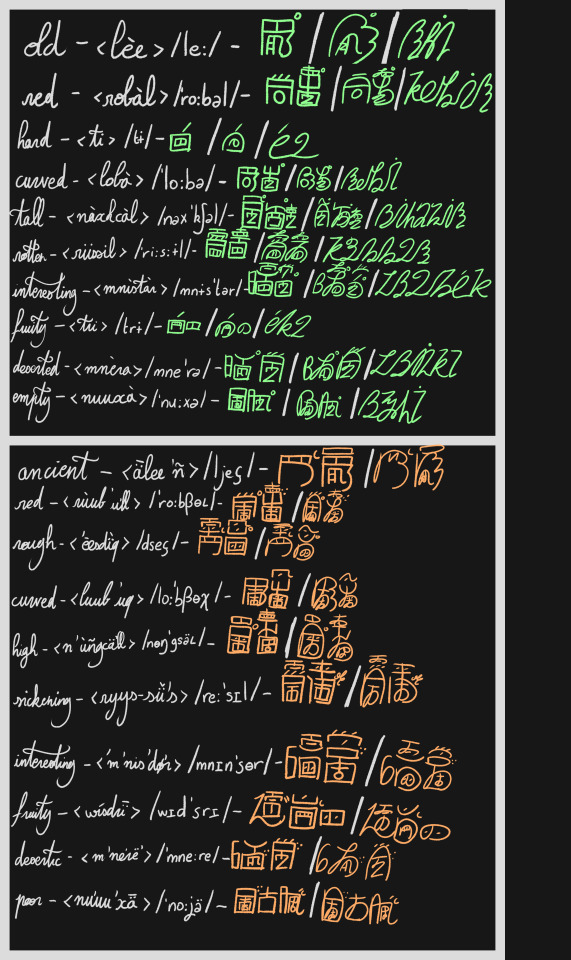
38 notes
·
View notes
